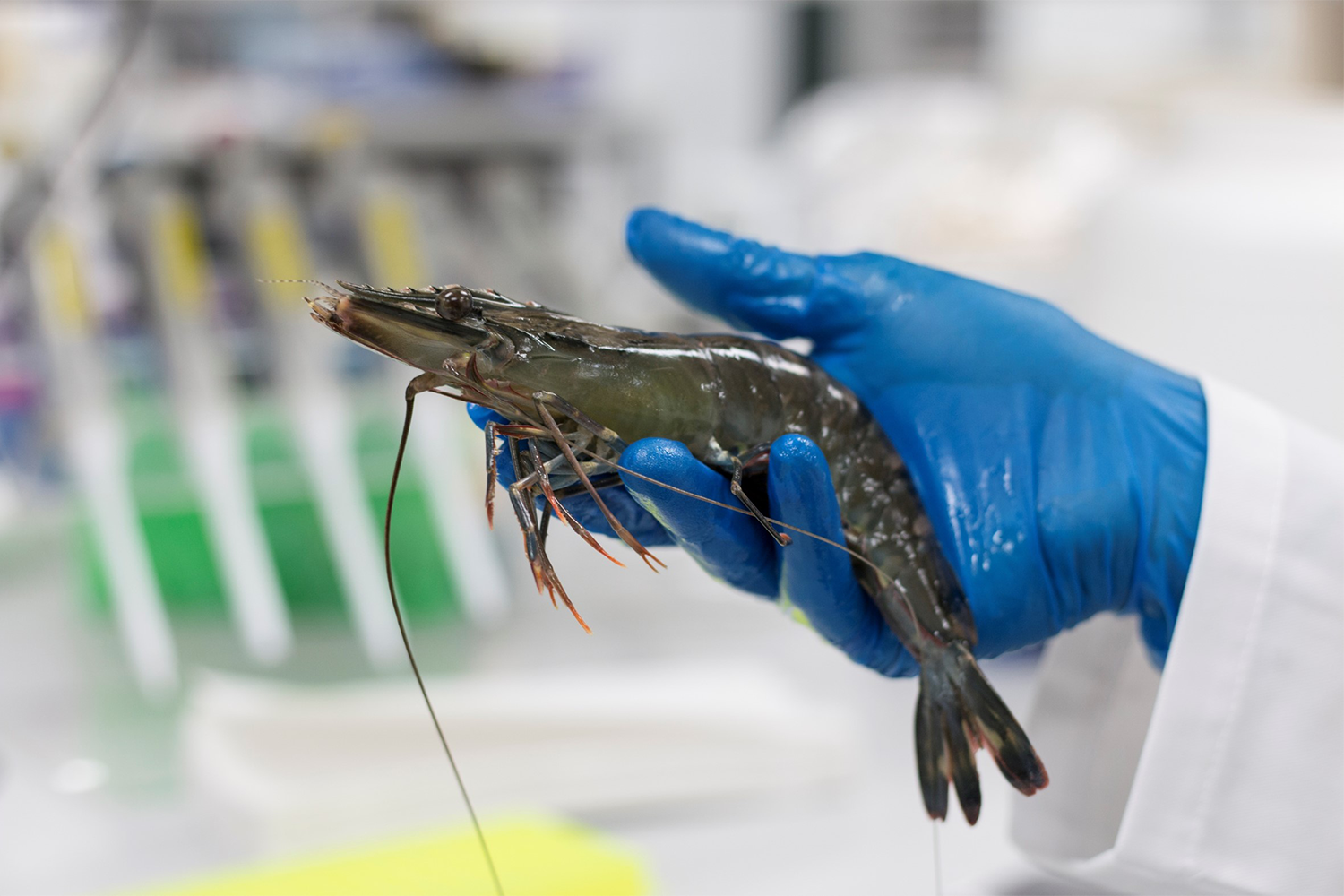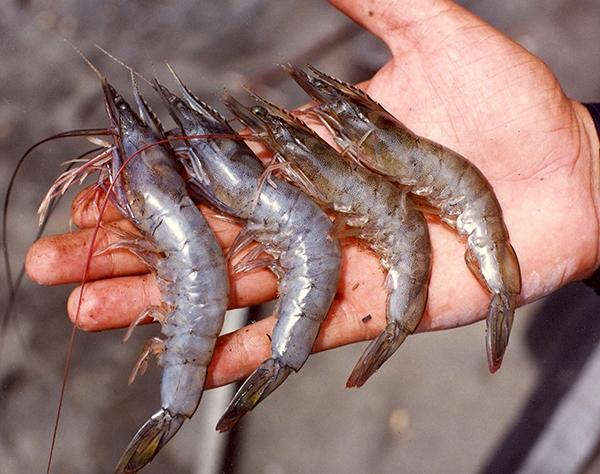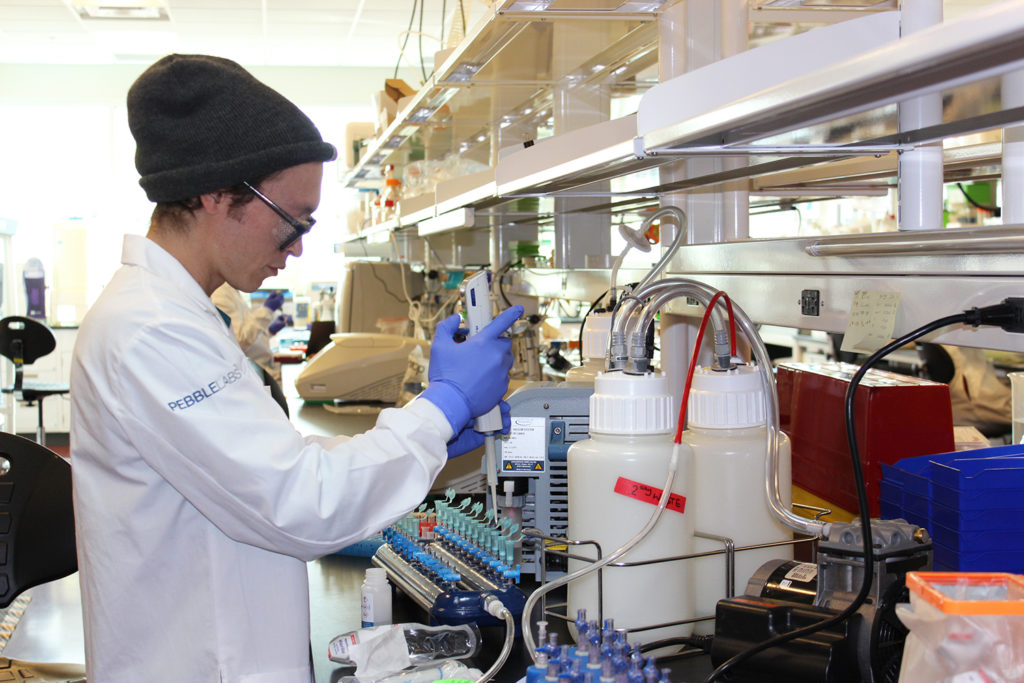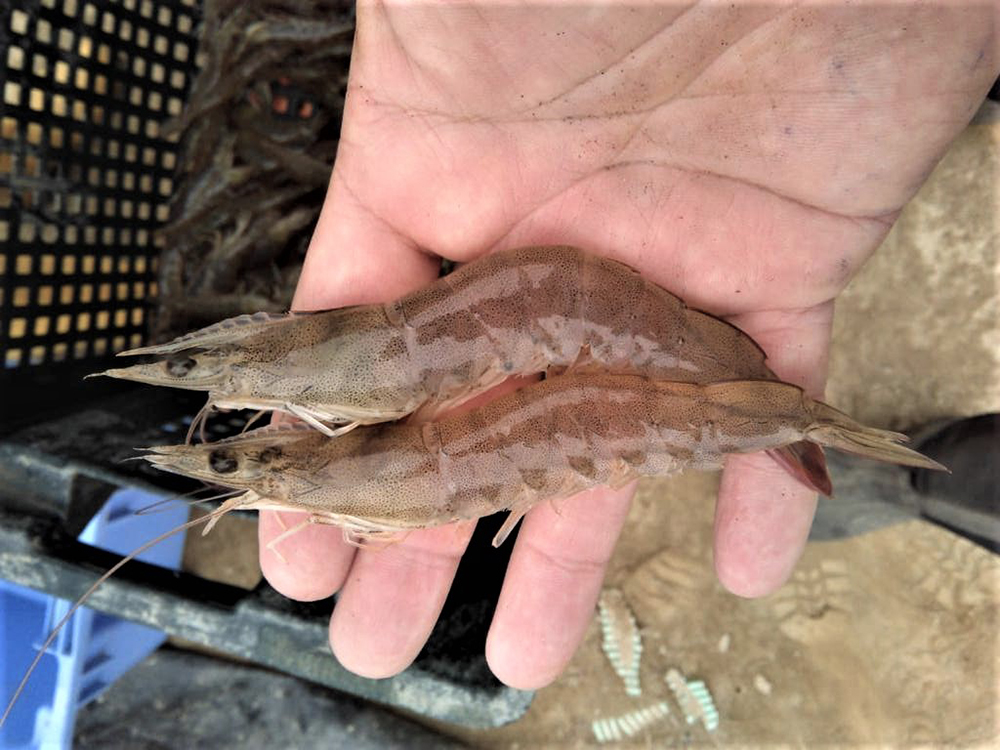Early pathogen detection is one way to reduce crop risk from White Spot Syndrome Virus and many other shrimp pathogens

The White Spot Syndrome virus (WSSV) remains one of the most devastating shrimp pathogens globally. Due to its broad host and vector range, WSSV is efficiently transmitted within and between aquatic environments. The virus is highly transmissible and infects all cultured penaeid shrimp with a devastating U.S. $1 billion impact annually on global shrimp culture. The Australian outbreak in 2016–17 alone cost this domestic industry $29 million.
The introduction of Specific Pathogen Free or WSSV-specific pathogen tolerant breeding stocks has been initially successful in starting to control the disease. However, with most shrimp farming currently not occurring under needed biosecure conditions, WSSV continues to cause major economic loss through horizontal transmission on farms. Implementation of biosecurity measures and pathogen screening strategies for early detection and early mitigation has become exceptionally important.
Highly sensitive and specific diagnostic tests are necessary to confirm the freedom of WSSV in apparently healthy shrimp and give farmers peace of mind. This cannot be achieved with many of the point of care or on-farm use tests in the market simply as they are not sensitive enough when used on shrimp tissue which contains various PCR inhibitors such as chitin. Diagnostic tests are ideally validated as recommended by the World Organisation for Animal Health (WOAH).
The validation pathway proves a test’s fitness for purpose in three stages. Stage 1 includes assessing an assay’s ability to reliably distinguish a specific pathogen from other pathogens (analytical specificity), to recognize a certain amount of a particular pathogen (limit of detection) and to produce consistent results with each repetition (repeatability). In stage 2 the diagnostic performance determines the proportion of correct positive (diagnostic sensitivity) and correct negative (diagnostic specificity) test results in a population of infected animals, and in stage 3 the reproducibility proves a test’s ability to produce consistent results from the same sample when tested in different laboratories.
Study setup
In this study, Genics’ Shrimp MultiPath™ (SMP) WSSV assay was validated according to the above-described pathway and compared to the two currently used WSSV quantitative PCR (qPCR) assays recommended by WOAH and the Australian Government. Pacific white shrimp (Penaeus vannamei) tissue samples were collected from individual ponds in Latin America to represent three independent experimental populations with 99, 100 and 83 shrimp represented in each.
Shrimp tissues were analysed for the presence or absence of WSSV using the Shrimp MultiPath™ WSSV PCR-based multiplex assay, which is available commercially as a service at Genics Pty Ltd (Genics, Brisbane Australia). The detailed study can be found in the original article (Moser R.J., S.M. Firestone, L.M. Franz, B. Genz, and M.J. Sellars. 2023. Shrimp MultiPath™ multiplexed PCR white spot syndrome virus detection in penaeid shrimp. Dis Aquat Organ. 2023 Apr 19;153:95-105. PMID: 37073799).
Shrimp MultiPath™ is an affordable PCR-based assay that allows high throughput quantitative screening for WSSV and twelve additional shrimp pathogens in one sample in a highly quality controlled test. SMP is routinely used in forty-eight countries for commercial shrimp testing to ascertain freedom from infection of apparently healthy animals, translocation testing and confirmation of clinical disease for the purpose of Aquaculture Health and in conjunction with Advanced Breeding Strategies. Additionally, Shrimp MultiPath™ is used by the Australian shrimp industry for all government-regulated translocation testing.
Australian shrimp growers demonstrate how to farm black tigers with WSSV knocking on their door
Results and discussion
SMP WSSV, assay validation metrics were established in comparison to the WOAH and CSIRO qPCR methods, with all having comparable limits of detection (LOD) at 2.9, 2.8 and 2.4 virus copies per reaction, respectively (Table 1).
Sellars, WSSV detection, Table 1
| Parameter | SMP Copies | WOAH qPCR | CSIRO qPCR |
|---|---|---|---|
| Limit of detection (LOD) | 2.9 copies | 2.8 copies | 2.4 copies |
| Analytical specificity (ASp) | 100% | 100%* | 100%* |
| Repeatability (intra-assay variation) | < 5% RSD | < 5% RSD*. | < 5% RSD* |
| Repeatability (inter-run variation) | < 5% RSD | < 5% RSD* | < 5% RSD* |
| Diagnostic Sensitivity (DSe) | 94.90% | 77.20% | 91.60% |
| Diagnostic Specificity (DSp) | 99.40% | 99.60% | 99.50% |
With >10,000 samples processed on SMP annually, analytical specificity has been determined to be at 100 percent. SMP WSSV does not cross-react with any other pathogen, nor does any interference occur when run in other shrimp species or even other organisms (sandworms). Background pathogens that have been confirmed in samples free from WSSV as part of the SMP panel include Hepatopancreatic Parvovirus (HPV), Infectious hypodermal and hematopoietic necrosis virus (IHHNV), Acute Hepatopancreatic Necrosis Disease (AHPND), Enterocytozoon hepatopenaei (EHP), Taura syndrome virus (TSV), Infectious myonecrosis virus (IMNV), Gill-associated virus (GAV), Yellow head virus (YHV) type 3 and 7, Monodon Baculovirus (MBV), Laem-Singh Virus (LSNV) and Mourilyan virus (MoV). Further, the analytical performance of SMP WSSV is continuously assessed through regular proficiency/ring testing rounds. SMP WSSV has demonstrated 100 percent conformance since commercialisation as have all other pathogen assays tested in the panel.
The SMP WSSV repeatability is equivalent with the CSIRO and WOAH qPCR assays and sits favourably below what is considered an acceptable range of ± four-fold difference in copy number between repeats.
To determine the diagnostic performance of SMP, a statistical model was used due to the absence of the perfect reference assay, with SMP outperforming standard tests. The model determined the median diagnostic sensitivity for the three assays to be 77.2 percent (WOAH qPCR), 91.6 percent (CSIRO qPCR) and 94.9 percent (SMP WSSV). These results are comparable to published diagnostic metrics for the qPCR assays with 76.8 percent (WOAH qPCR) and a relatively lower 82.9 percent (CSIRO qPCR) (Table 1).
Diagnostic specificity values are comparable for all three assays at approximately 99.5 percent. Diagnostic performance metrics for SMP WSSV are exceptionally good and align with WOAHs three fit-for-purpose use cases: (1) certify freedom from infection or presence of the agent in individual animals for trade movement purposes, (2) confirm a diagnosis of suspect or clinical cases, and (3) estimate prevalence of infection or exposure to facilitate risk analysis.
Perspectives
The global spread of devastating shrimp pathogens, along with the emergence of new pathogen threats, has made it crucial for the aquaculture industry to prioritize high standards in early pathogen detection and biosecurity measures.
These pathogens can have devastating effects on shrimp populations, leading to significant economic losses for the industry. Early detection is key in implementing effective control measures and preventing the spread of these pathogens. Point of care and pond-side testing available in the market are typically not sensitive enough for this purpose.
Genics’ Shrimp MultiPath™ technology offers an affordable high throughput multi-pathogen detection platform that includes assays such as the WSSV assay that are equal to global standards regarding analytical and diagnostic sensitivity and specificity. Therefore, SMP is the ideal tool for effective surveillance testing and targeted diagnosis as part of cohesive biosecurity measures allowing the shrimp industries and authorities to receive early alerts about potential threats of WSSV in global shrimp populations. The application of Shrimp MultiPath™ for early detection and risk mitigation can be the difference between harvesting or not harvesting at all.
Now that you've reached the end of the article ...
… please consider supporting GSA’s mission to advance responsible seafood practices through education, advocacy and third-party assurances. The Advocate aims to document the evolution of responsible seafood practices and share the expansive knowledge of our vast network of contributors.
By becoming a Global Seafood Alliance member, you’re ensuring that all of the pre-competitive work we do through member benefits, resources and events can continue. Individual membership costs just $50 a year.
Not a GSA member? Join us.
Authors
-
Ralf J. Moser, Ph.D.
Genics Pty Ltd.
Level 5, Gehrman Building, 60 Research Road, St Lucia, Qld, Australia 4067
-
Berit Genz, Ph.D.
Genics Pty Ltd.
Level 5, Gehrman Building, 60 Research Road, St Lucia, Qld, Australia 4067
-
Melony J. Sellars, Ph.D.
Corresponding author
Genics Pty Ltd.
Level 5, Gehrman Building, 60 Research Road, St Lucia, Qld, Australia 4067[109,111,99,46,115,99,105,110,101,103,64,115,114,97,108,108,101,83,46,121,110,111,108,101,77]
Related Posts

Health & Welfare
A comprehensive look at the Proficiency Test for farmed shrimp
The University of Arizona Aquaculture Pathology Laboratory has carried out the Proficiency Test (PT) since 2005, with 300-plus diagnostic laboratories participating while improving their capabilities in the diagnosis of several shrimp pathogens.

Health & Welfare
Current status of IHHNV infection in Peru’s and Ecuador’s shrimp industries
The virus-host relationship, where circulating genotypes of IHHNV co-exist with farmed Pacific white shrimp, is potentially evolving, authors find.

Health & Welfare
Can shrimp diseases be beaten by bacterial interference?
Biotech company Pebble Labs is harnessing bacteria to block the transmission of virulent shrimp diseases in a process known as RNA interference, or RNAi.

Health & Welfare
Electrochemical detection of WSSV with disposable electrode
Authors demonstrate the detection of White Spot Syndrome Virus – a serious pathogen of cultured shrimp – by a nanofabricated sensing disposable electrode.



